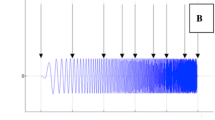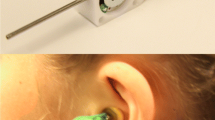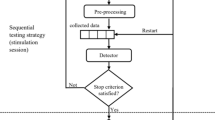Abstract
Transient otoacoustic emission (TEOAE) is a method widely used in clinical practice for assessment of hearing quality. The main problem in TEOAE detection is its much lower level than the level of environmental and biological noise. While the environmental noise level can be controlled, the biological noise can be only reduced by appropriate signal processing. This paper presents a new two-probe preprocessing TEOAE system for suppression of the biological noise by adaptive filtering. The system records biological noises in both ears and applies a specific adaptive filtering approach for suppression of biological noise in the ear canal with TEOAE. The adaptive filtering approach includes robust sign error LMS algorithm, stimuli response summation according to the derived non-linear response (DNLR) technique, subtraction of the estimated TEOAE signal and residual noise suppression. The proposed TEOAE detection system is tested by three quality measures: signal-to-noise ratio (S/N), reproducibility of TEOAE, and measurement time. The maximal TEOAE detection improvement is dependent on the coherence function between biological noise in left and right ears. The experimental results show maximal improvement of 7 dB in S/N, improvement in reproducibility near 40% and reduction in duration of TEOAE measurement of over 30%.










Similar content being viewed by others
References
Arslan, R. B., O. Ozdamar, and Y. Ülgen. Digital subtraction method for transient evoked otoacoustic emission recording with ipsilateral noise suppression: an application to stimulus artifact reduction. Audiology 40:55–62, 2001.
Bray, P., and D. Kemp. An advanced cochlear echo technique suitable for infant screening. Br. J. Audiol. 21:191–204, 1987.
Dalmay, F., M. T. Antonini, P. Marquet, and R. Menier. Acoustic properties of the normal chest. Eur. Respir. J. 8:1761–1769, 1995.
Delgado, R. E., Ö. Özdamar, S. Rahman, and C. N. Lopez. Adaptive noise cancellation in a multimicrophone system for distortion product otoacoustic emission acquisition. IEEE Trans. Biomed. Eng. 47:1154–1164, 2000.
Dirckx, J. J. J., K. Daeroers, Th. Somers, F. E. Offeciers, and P. J. Govaerts. Numerical assessment of TOAE screening results: currently used criteria and their effect on TOAE prevalence figures. Acta Otolaryngol. Stockh. 116:672–679, 1996.
Farhang-Boroujeny, B. Adaptive Filters: Theory and Applications. New York: John Wiley & Sons, Inc., 1998.
Fitzgerald, T. S., and B. A. Prieve. COAE thresholds: 1. Effects of equal-amplitude versus subtraction methods. J. Speech Lang. Hear. Res. 40:1164–1176, 1997.
Grandori, F., and P. Ravazzani. Non-linearities of click-evoked otoacoustic emissions and the derived non-linear technique. Br. J. Audiol. 27:97, 1993.
Hall, J. W. Handbook of Otoacoustic Emissions. San Diego: Singular Publishing Group, 2000.
Kei, J., R. Sockalingam, C. Holloway, A. Agyik, C. Brinin, and D. Baine. Transient evoked otoacoustic emissions in adults: a comparison between two test protocols. J. Am. Acad. Audiol. 14:563–573, 2003.
Kemp, D. T. Otoacoustic emissions, their origin in cochlear function and use. Br. Med. Bull. 63:223–241, 2002.
Kemp, D. T., P. Bray, L. Alexander, and A. M. Brown. Acoustic emission cochleography practical aspects. Scand. Audiol. 25:71–94, 1986.
Killion, M. C. Noise and microphones. J. Acoust. Soc. Am. 59:424–433, 1976.
Lasky, R. E. Distortion product otoacoustic emissions in human newborns and adults. I. Frequency effects. J. Acoust. Soc. Am. 103:981–991, 1998.
Muller, P., and M. Kompis. Evaluation of a noise reduction system for the assessment of click-evokated otoacoustic emissions. J. Acoust. Soc. Am. 112:164–171, 2002.
Neumann, J., S. S. Uppenkamp, and B. Kollmeier. Chirp evoked otoacoustic emissions. Hear. Res. 79:17–25, 1994.
Prieve, B. A., M. P. Gorga, A. Schmidt, S. Neely, J. Peters, L. Schultes, and W. Jesteadt. Analysis of transient-evoked otoacoustic emissions in normal-hearing and hearing-impaired ears. J. Acoust. Soc. Am. 93:3308–3319, 1993.
Rasmussen, A. N., P. A. Osterhammel, P. T. Johannesen, and B. Borgkvist. Neonatal hearing screening using otoacoustic emissions elicited by maximum length sequences. Br. J. Audiol. 32:355–366, 1998.
Robinette, M. S., and T. J. Glattke. Otoacoustic Emissions: Clinical Applications (2nd ed.). New York: Thieme, 2002.
Therrien, C. W. Overview of statistical signal processing. In: The Digital Signal Processing Handbook, edited by V. K. Madisetti. Boca Raton: CRC Press Taylor & Francis Group, 2010.
Thornton, A. R. D. High rate otoacoustic emissions. J. Acoust. Soc. Am. 94:132–136, 1993.
Tognola, G., F. Grandori, and P. Ravazzani. Data processing options and response scoring for OAE-based newborn hearing screening. J. Acoust. Soc. Am. 109:283–290, 2001.
Wang, M. E., and M. J. Crocker. On the application of coherence techniques for source identification in a multiple noise source environment. J. Acoust. Soc. Am. 74:861–872, 1983.
Whitehead, M. L., B. B. Stagner, B. L. Lonsbury-Martin, and G. K. Martin. Measurement of otoacoustic emissions for hearing assessment. IEEE Eng Med Biol 13:210–226, 1994.
Widmalm, S. E., D. Djurdjanovic, and D. C. McKay. The dynamic range of TMJ sounds. J. Oral Rehabil. 30:495–500, 2003.
Widrow, B., and S. Stearns. Adaptive Signal Processing. Englewood Cliffs, New York: Prentice Hall, 1985.
Zimatore, G., S. Hatzopoulos, A. Giuliani, A. Martini, and A. Colosimo. Comparison of transient otoacoustic emission responses from neonatal and adult ears. J. Appl. Physiol. 92:2521–2528, 2002.
Acknowledgments
This research was supported by Grants 178027 and TR32032 from the Ministry of Science and Technological Development of the Republic of Serbia.
Conflict of interest
The authors of the above paper state that they have no conflict of interest.
Author information
Authors and Affiliations
Corresponding author
Additional information
Associate Editor Berj L. Bardakjian oversaw the review of this article.
Rights and permissions
About this article
Cite this article
Subotić, M., Šarić, Z. & Jovičić, S.T. Adaptive Filter Based Two-Probe Noise Suppression System for Transient Evoked Otoacoustic Emission Detection. Ann Biomed Eng 40, 637–647 (2012). https://doi.org/10.1007/s10439-011-0430-2
Received:
Accepted:
Published:
Issue Date:
DOI: https://doi.org/10.1007/s10439-011-0430-2




